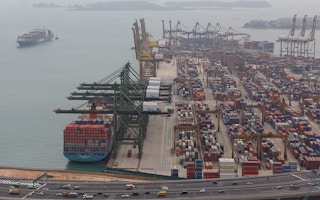Oil spills garner much public attention and anguish, but “biological spills” represent a greater long-term threat and do not have the same high public profile.
It was an exotic fungus that wiped out billions of American chestnut trees in the early 20th century, dramatically altering the landscape and ecosystem, while today the emerald ash borer - another pest that hitch-hiked along global trade routes to new habitats - threatens to do the same with a valuable tree long used by humans to make tool handles, guitars and office furniture.
Perhaps the biggest “biological spill” of all was when a fungus-like eukaryotic microorganism called Phytophthora infestans - the name of the genus comes from Greek for “plant destroyer” - sailed from the Americas to Belgium. Within months it arrived in Ireland, triggering a potato blight that led to famine, death and mass migration.
The list goes on and on. A relative of the toxic cane toad that has run rampant in Australia recently disembarked from a container carrying freight to Madagascar, a biodiversity hotspot, and the ability of females to lay up to 40,000 eggs a year make it a catastrophic threat for local lemurs and birds, while also threatening the habitat of a host of animals and plants.
In Rome, municipal authorities are ramping up their annual campaign against the tiger mosquito, an invasive species that arrived by ship in Albania in the 1970s. Aedes albopictus, famous for its aggressive biting, is now prolific across Italy and global warming will make swathes of northern Europe ripe for colonisation.
“
The crop losses and control costs triggered by exotic pests amount to a hefty tax on food, fibre and forage production.
Craig Fedchock, coordinator, International Plant Protection Convention Secretariat
This is why the nations of the world came together some six decades ago to establish the International Plant Protection Convention (IPPC) as a means to help stem the spread of plant pests and diseases across border boundaries via international trade and to protect farmers, foresters, biodiversity, the environment, and consumers.
“The crop losses and control costs triggered by exotic pests amount to a hefty tax on food, fibre and forage production,” says Craig Fedchock, coordinator of the FAO-based IPPC Secretariat. “All told, fruit flies, beetles, fungi and their kin reduce global crop yields by between 20 and 40 per cent,” he explains.
Trade as a vector, containers as a vehicle
Invasive species arrive in new habitats through various channels, but shipping, is the main one.
And shipping today means sea containers: Globally, around 527 million sea container trips are made each year - China alone deals with over 133 million sea containers annually. It is not only their cargo, but the steel contraptions themselves, that can serve as vectors for the spread of exotic species capable of wreaking ecological and agricultural havoc.
For example, an analysis of 116,701 empty sea containers arriving in New Zealand over the past five years showed that one in 10 was contaminated on the outside, twice the rate of interior contamination. Unwelcome pests included the gypsy moth, the Giant African snail, Argentine ants and the brown marmorated stink bug, each of which threaten crops, forests and urban environments. Soil residues, meanwhile, can contain the seeds of invasive plants, nematodes and plant pathogens.
“Inspection records from the United States, Australia, China and New Zealand indicate that thousands of organisms from a wide range of taxa are being moved unintentionally with sea containers,” the study’s lead scientist, Eckehard Brockerhoff of the New Zealand Forest Research Institute, told a recent meeting at FAO of the Commission on Phytosanitary Measures (CPM), IPPC’s governing body.
Stink bugs and the supply chain
Damage exceeds well beyond agriculture and human health issues. Invasive species can cause clogged waterways and power plant shutdowns.
Biological invasions inflict damages amounting to around five percent of annual global economic activity, equivalent to about a decade’s worth of natural disasters, according to one study. Factoring in harder-to-measure impacts may double that, Brockerhoff said.
Around 90 per cent of world trade is carried by sea today, with a vast panoply of differing logistics, making agreement on an inspection method elusive. Some 12 million containers entered the U.S. last year, using no fewer than 77 ports of entry.
This story was published with permission from the United Nations Food and Agriculture Organisation. Read the full story.










